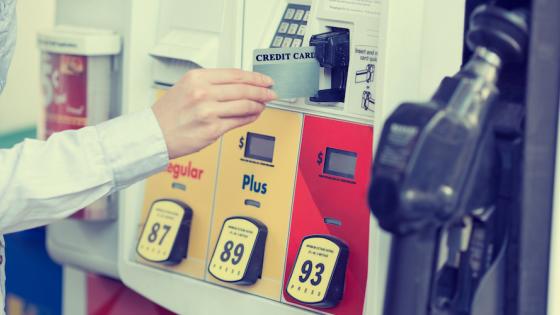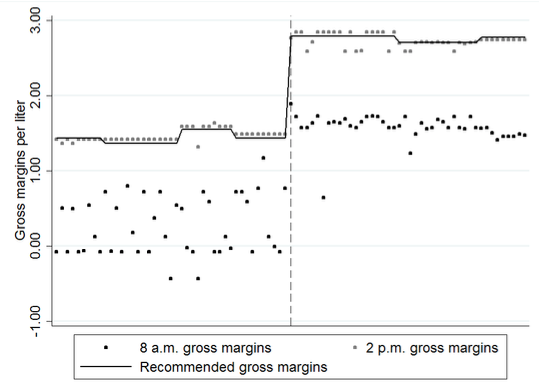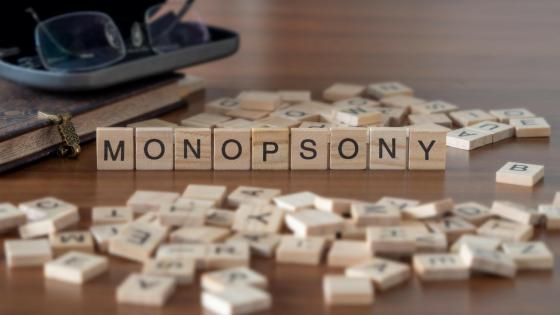If firms charge uniform prices independently of when consumers make their purchases, the attention of price-sensitive consumers is exclusively on where to buy. In many markets, we instead see saw-tooth-shaped price patterns. Examples are some retail gasoline markets (see Noel 2016 for a comprehensive survey). If these patterns are regular, consumers benefit if they focus on when, rather than where, to buy.
When consumers learn that attention towards whento buy is more effective, they may reduce their search for the cheapest provider at any given time. For example, Black Friday (the day after Thanksgiving in the US, on which many shops offer 24-hour discounts, particularly on electronic products) is a time-constrained low-price window. For Black Friday-like regimes, price comparisons between sellers at one time may be difficult to do. Therefore, if you are buying electronic products, it may be more efficient to use more effort to decide when to buy.
For firms, if they expect price wars to end at a given time, they do not need to be concerned about further undercutting. Competition in low-price windows may be intensified.
There are several ways to explain the firm behaviour that creates the saw-tooth price waves when price wars come and go. In gasoline retailing, empirical studies find that saw-tooth price waves may be explained as the outcome of a sequential competitive pricing game. These are known as Edgeworth cycles, as formalised by Maskin and Tirole (1988). The source of such waves may also be intertemporal price discrimination (Conlisk et al. 1984 among others). Strategic obfuscation is another explanation, in which firms find it profitable to add complexity to soften price competition (Carlin 2009, Ellison and Wolitzky 2012).
The Norwegian retail gasoline market
In recent work (Foros et al. 2017), we investigated the Norwegian retail gasoline market. From 2004 to 2017, the four major retail chains have taken a 'day off' from competition on Mondays. Every Monday around noon, all retail outlets symmetrically raise their pump prices to restore the price recommended by retail chain headquarters (Foros and Steen 2013). In local markets, where the degree of local competition is smallbecause there is long distance between competing outlets, retail prices are always equal to the recommended price. Therefore, the recommended price is the monopoly price. In local markets, where there is more competition, firms undercut each other during the rest of the week.
From 2008, retail chains introduced another day off from competition on Thursdays. As on Mondays, there is industry-wide synchronisation to restore retail prices to recommended prices every Thursday.Figure 1 shows the pattern for one station.
Figure 1 Retail prices and recommended prices for one gasoline station from 2 September to 31 October 2015
Source: Foros et al. (2017).
Note: Black dashed lines mark Mondays, while grey dashed lines mark Thursdays. €1 ≈ 9.50 Norwegian krone.
If one of the four retail chains deviates from the established practice, the rivals can easily detect it, because recommended prices are published on the retail chains’ websites. Hence, they coordinate over whenthe prices should increase (Monday and Thursday) and to what level(the recommended price) without direct communication.
Figure 2 shows the margins on the restoration day.
- There is a significant difference between morning and afternoon gross margins across all retailers.
- Between 2008 and 2015, gross margins have increased both when prices are at their highest, after restoration, and when prices are lowest, immediately before restoration.
- As morning prices on restoration days are typically also the lowest prices of the weekly cycle Figure 2 indicates that, from the consumers’ perspective, using effort on when rather than where to buy is most efficient.
Figure 2 Gross margins in Norwegian krone for gasoline stations in Oslo on Monday 21 April 2008 and Monday 24 August 2015
Source: Foros et al. (2017).
Notes: Margins are in real terms, 2015 krone = 1. Each black mark and corresponding grey mark vertically above it are observations for one station. The 2008 observations are to the left of the vertical dashed line, while 2015 observations are to right of the same line. €1 ≈ 9.50 Norwegian krone.
The additional restoration day allows analysis of how regular days off from competition influence consumer behaviour and firm profitability. We used a panel dataset of daily gasoline prices covering periods between 2004 and 2015 to investigate the effect of a second restoration day on profitability over time. The introduction of another day off from competition increased gross margins throughout the week. Firms use significant effort to ensure that the system is in use every week, and therefore these findings are consistent with that effort.
We also investigate how consumer behaviour influences firm profitability by matching demand-side variables from a survey dataset with the price panel. The survey is carried out in four years between 2005 and 2015, and allowed us to scrutinise the interaction between the demand and supply sides of a market with next-to-perfectly predictable prices.
Results show that the Monday restoration increases firms’ profitability by 35.6%, and the Thursday restoration increases profitability by 22.2%. The results suggest that when more consumers spend effort on when to buy rather than where to buy, competition softens. This shift in consumer behaviour de-incentivises firms to compete, since competition will only marginally affect consumer choice of station during the two brief time windows with lower prices. The introduction of a second restoration day reduces the time window with normal price competition, and increases profitability.
Policy implications
For policymakers and consumer associations this creates a difficult trade-off when advising consumers. On one hand, there are huge savings for consumers if they adapt to the pattern and fill up in the window when prices are low. On the other hand, if more consumers pay less attention to where to buy, retailers lose the incentive to compete aggressively. In this respect, the weekly price pattern has been given a great deal of media coverage since it began in 2004.
Despite an almost perfectly predictable time-dependent price pattern, consumer awareness of the pattern is remarkably low. The survey in Foros et al. (2017) shows that even after more than 10 years, only 81% of consumers think that prices increase on certain days, and this statistic has increased slowly from 35% in 2005. When asked if they have adapted to this pattern, around one-third of consumers said they had. The Norwegian Competition Authority (2014) also confirms this finding. Using data on price and quantity from 2004 to 2011 for the entire population of stations in Norway, they show that consumers have only marginally adjusted to the price pattern by moving their purchases to the low-price window on Sundays and Monday mornings.
References
Carlin, B I (2009), "Strategic price complexity in retail financial markets", Journal of Financial Economics 91(3): 278-287.
Conlisk, J, E Gerstner, and J Sobel (1984), "Cyclic Pricing by a Durable Goods Monopolist", The Quarterly Journal of Economics 99(3): 489-505.
Ellison, G and A Wolitzky (2012), "A search cost model of obfuscation", The RAND Journal of Economics 43(3): 417-441.
Foros, Ø and F Steen (2013), "Vertical Control and Price Cycles in Gasoline Retailing", The Scandinavian Journal of Economics 115(3): 640-661.
Foros, Ø, M Nguyen-Ones and F Steen (2017), "The Effects of a Day Off from Retail Price Competition: Evidence on Consumer Behavior and Firm Performance in Gasoline Retailing", CEPR Discussion Paper 12477.
Maskin, E and J Tirole (1988), "A Theory of Dynamic Oligopoly, ii: Price Competition, Kinked Demand Curves, and Edgeworth Cycles", Econometrica 56(3): 571-599.
Noel, M D (2016), "Retail Gasoline Markets", in E. Basker (ed), Handbook on the Economics of Retailing and Distribution, Edward Elgar Publishing.
Norwegian Competition Authority (2014), The Retail Gasoline Market in Norway - Increase in Margin and New Price Peak.








